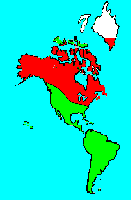SPECIES INFO
Slender leaf sundew (Drosera linearis) is found in North America near the eastern coast and near the Great Lakes. This is usually found in bogs. This small plant rarely exceeds 5 inches in height. The leaves have long petioles and the blades are narrow lanceolate. The leaves normally are taller than the flower stalk. This sundew can have a solitary flower, or occasionally up to 4 white flowers.Drosera genus is found almost worldwide. The genus is abundant in Australia. There are about 100 species in this genus. These are primarily carnivorous perennial herbs. There are seven species, two hybrids, and five subspecies growing in greater North America. These plants are usually found in bogs and rich damp woods or swamps.
Sundews (Family Droseraceae) is found in most of North America except for the Rocky Mountains and the southwestern desert. This family is also found widely in South America, but is absent from the dry area south of the Amazon. In the Old World, this family is found widely in Africa south of the northern desert. In Eurasia, this family is not found in the drier areas of the Near East and associated adjacent eastern dry areas. This family contains four genera and about 100 species of which many are native to Australia in the genus Drosera. There are eight species in two genera established in greater North America.
This family contains herbs that are mostly found in bogs and very wet places. The leaves are alternate usually in a basal rosette. The leaves end in stalked glands that can attract and adhere to insects.
Insect Eating Plants (Order Sarraceniales) are found worldwide in selected non desert areas. These plants are usually broken into three different families.
Dicots (Dicotyledoneae Class) are the predominant group of vascular plants on earth. With the exception of the grasses (Monocots) and the Conifers (Gymnosperms), most of the larger plants that one encounters are Dicots. Dicots are characterized by having a seed with two outer shell coverings.
Some of the more primitive Dicots are the typical hardwood trees (oaks, birches, hickories, etc). The more advanced Dicots include many of the Composite (Aster) Family flowers like the Dandelion, Aster, Thistles, and Sunflowers. Although many Monocots reach a very high degree of specialization, most botanists feel that the Dicots represent the most advanced group of plants.
Seed plants (Phylum Embryophyta) are generally grouped into one large phylum containing three major classes: the Gymnosperms, the Monocots, and the Dicots. (Some scientists separate the Gymnosperms into a separate phylum and refer to the remaining plants as flowering plants or Angiospermae.)
For North American counts of the number of species in each genus and family, the primary reference has been John T. Kartesz, author of A Synonymized Checklist of the Vascular Flora of the United States, Canada, and Greenland (1994). The geographical scope of his lists include, as part of greater North America, Hawaii, Alaska, Greenland, Puerto Rico, and the Virgin Islands.
Kartesz lists 21,757 species of vascular plants comprising the ferns, gymnosperms and flowering plants as being found in greater North America (including Alaska, Hawaii, Greenland, Puerto Rico and the Virgin Islands.
There are estimates within the scientific world that about half of the listed North American seed plants were originally native with the balance being comprised of Eurasian and tropical plants that have become established.
Plant kingdom contains a large variety of different organisms including mosses, ferns, and seed plants. Most plants manufacture their energy from sunlight and water. Identification of many species is difficult in that most individual plants have characteristics that have variables based on soil moisture, soil chemistry, and sunlight.
Because of the difficulty in learning and identifying different plant groups, specialists have emerged that study only a limited group of plants. These specialists revise the taxonomy and give us detailed descriptions and ranges of the various species. Their results are published in technical journals and written with highly specialized words that apply to a specific group.
On the other hand, there are the nature publishers. These people and companies undertake the challenging task of trying to provide easy to use pictures and descriptions to identify those species.


